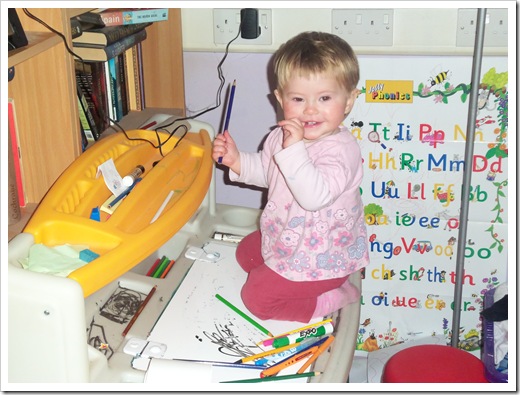14-month-old – strategies
So as a parent of a… well, of a child… there are certain tricks or strategies that are required to get the child to do what you want them to do, or not to do what you don’t want them to do – or just to keep you reasonably sane.
Having done this once before, you would think that I’d remember all these tricks and strategies, but it’s amazing how much you forget. And, of course, the second (or subsequent) child can actually be quite different from the first, so you have to come up with new ones. Here are some of those I’ve (or we’ve) come up with recently.
Not wanting to have her nappy changed
Instead of saying ‘No! Come here. Don’t roll over! No, Eleanor! Don’t roll over! Oh crap, you’ve got poo all over me. Again!’ I give her something to play with/chew on and sing a song. The song that seems to work best at the moment is One, Two, Three, Four, Five, Once I caught a fish alive, though some other nursery rhymes help, too. At the moment, I can usually keep her on the mat until her bum is clean. I then have to chase her round the room to get her clean nappy on and clothes back on. But I’m not covered in poo, which is always a bonus.
Not wanting to get in the buggy
Well, this is fairly similar and, in fact, many situations where she doesn’t want to do what I want her to can be solved by singing One, Two, Three, Four, Five, Once I caught a fish alive. Sometimes she requires a snack (apple rice cake or carrot puff, though she’d probably prefer some chocolate) and sometimes a toy to play with/chew on, too. And, yes, actually, sometimes she just has to be held down and strapped in.
Interestingly, she has no problem getting in the backpack – probably because it’s much more fun riding around up high where she can see people, than being stuck down near the ground.
Getting into the kitchen cupboards
I honestly don’t recall Rosemary getting into the kitchen cupboards. This may well be because, as a first child, we never ever left her alone for one second, so she didn’t have the opportunity. Now, the obvious solution is, of course, to move the dangerous/breakable things to a different spot and put the unproblematic things in the accessible cupboards. But we haven’t got around to doing that, because we keep thinking it’s not going to last much longer, so there’s no point. I have a feeling she’s going to keep it up until next Christmas, just to show us.
Failing the sensible route, what we do is allow and even sometimes encourage her using the cupboards in good ways. For example, she’s rather fond of getting out tins of anchovies and taking them for a walk in her buggy – sadly, we lost a couple of tins recently, though, so the replacement is currently sat on a high shelf. We may bulk-buy them in future, to be on the safe side. She does often try to get things out of the bin, but recently she’s been picking up rubbish off the floor and putting it in the bin (yes, I have absolutely no idea where she got the tidy gene – skipped a generation somewhere, I imagine), and we have been applauding that – literally, clap, clap, clap. The cupboard opposite the fridge has glass bowls and baking tins in, but she usually just gets out the Silicon loaf tin, which we are quite happy with.
There are still a fair few ‘No’s in the kitchen, though, such as the dishwasher tablets (wrapped up, so not immediately dangerous), which end up strewn round the floor and the open packets of pasta, which also end up strewn round the floor. Oh, and she keeps turning the dishwasher on again, just after it’s finished, which negates the whole drying process entirely. Ah well, you win some you lose some.
Offering a distraction, especially a book
Many undesired behaviours can be turned around by providing some kind of distraction. I’ve mentioned the singing already, but others include dancing crazily, doing exaggerated laughs, and offering to read her a book. She is very into books and will frequently be turned away from something not so good by a book.
Offering food
Already mentioned under the buggy persuasion, but food is a great distraction, though only if offered on the move – getting her to sit in her highchair is a whole other problem.
These are just a few of the things I’ve (and we’ve) come up with recently. Do you have any others that you use/have used? Did you find you needed different strategies second time round or did the first ones still work? Had you forgotten them all by the time you were at that stage with the second (or subsequent) child?


Leave a Reply